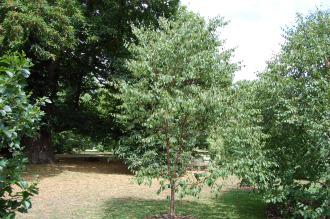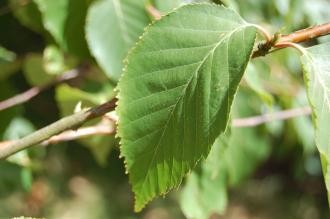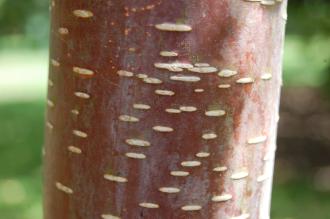
Betula utilis Bark (18/07/2015, Kew Gardens, London)
Position: Full sun to partial shade
Flowering period: Late Spring
Soil: Moist, well drained
Eventual Height: 20m
Eventual Spread: 12m
Hardiness: 4a, 4b, 5a, 5b, 6a, 6b, 7a, 7b, 8a, 8b, 9a
Family: Betulaceae
Betula utilis is a small deciduous tree with an open habit. Its light green leaves are ovate with serrate margins, up to 9cm long and 5cm across. Its leaves turn yellow in autumn before they fall. Its orange/ light brown bark has cream lenticels running horizontally. Its flowers are male and female catkins. Its fruit of the female catkins are dispersed by wind.

Betula utilis Bark Leaf (18/07/2015, Kew Gardens, London)
Betula utilis, commonly known as Chinese Red Birch or Himalayan Birch, is native to central China. In its native habitat it grows with scattered conifers with an understory of shrubs.
The etymological root of the binomial name Betula is the old Latin name for the Birch tree. Utilis is from the Latin meaning ‘useful’ and refers to the usefulness of its bark.

Betula utilis Bark (18/07/2015, Kew Gardens, London)
The landscape architect may find Betula utilis useful as a small deciduous tree with attractive bark and an open habit which provides dappled shade.
Betula utilis prefers moist, well-drained soils. It tolerates most pH of soil.
Betula utilis requires little to no maintenance. The lower branches may be pruned back to reveal the bark at eye level.

Landscape Architecture

